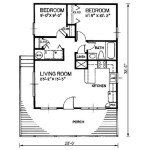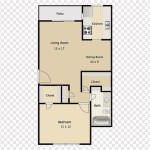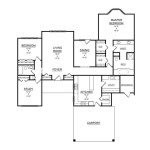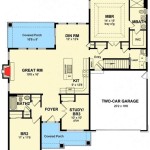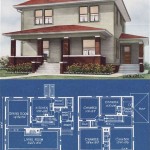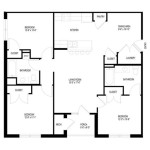Best Free Floor Plan Creator: A Comprehensive Guide
Creating a floor plan is a crucial step in various projects, from designing a dream home to planning an office renovation. The ability to visualize the layout and spatial relationships before physical construction begins can save considerable time, money, and effort. Numerous software solutions cater to this need, offering a range of features and functionalities. While professional-grade tools often come with a hefty price tag, several free floor plan creators provide surprisingly robust capabilities for basic to intermediate design needs. This article will explore some of the best free options available, analyzing their strengths, weaknesses, and suitability for different user profiles.
Before delving into specific software recommendations, it's important to define what constitutes a "floor plan creator" and what features are generally expected. At its core, a floor plan creator is a software application that allows users to draw and manipulate architectural plans in a digital environment. These plans typically include representations of walls, doors, windows, furniture, and other architectural elements. The software should enable users to accurately depict room dimensions, calculate square footage, and visualize the overall spatial arrangement. Advanced features might include 3D modeling, material selection, and collaborative editing capabilities.
The "free" aspect can manifest in different ways. Some software offers a fully functional free version with limited features, while others operate on a freemium model, providing basic tools for free and charging for more advanced functionalities. Still others are completely free and open-source, supported by a community of developers and users. The choice ultimately depends on the specific needs of the project and the level of functionality required.
Key Considerations When Choosing a Free Floor Plan Creator
Selecting the right free floor plan creator hinges on several critical factors. These considerations will help narrow down the options and ensure that the chosen software aligns with the project's objectives and the user's technical proficiency.
Ease of Use: A user-friendly interface is paramount, especially for individuals with limited experience in architectural design. The software should be intuitive to navigate, with clear instructions and readily accessible tools. Drag-and-drop functionality, pre-designed templates, and helpful tutorials can significantly reduce the learning curve.
Features and Functionality: The available features must be adequate for the intended purpose. Consider whether the software supports the creation of accurate wall dimensions, the placement of doors and windows, the addition of furniture and appliances, and the calculation of area measurements. 3D visualization capabilities can also be a significant advantage for understanding the spatial relationships within the floor plan.
File Format Compatibility: The ability to import and export floor plans in various file formats is crucial for collaboration and integration with other software applications. Common file formats include DWG, DXF, PDF, and image formats such as JPEG and PNG. Compatibility with these formats allows for seamless sharing of designs with architects, contractors, and other stakeholders.
Platform Compatibility: Determine whether the software is compatible with the operating system (Windows, macOS, Linux) and devices (desktop, laptop, tablet) that will be used for the design process. Some floor plan creators are web-based, offering accessibility from any device with an internet connection, while others require installation on a local machine.
Support and Resources: Access to adequate support and resources can be invaluable when encountering difficulties or seeking guidance. Look for software that provides online documentation, tutorials, forums, or a community of users who can offer assistance. A responsive support team can also be a significant asset.
Recommended Free Floor Plan Creators
Based on the criteria outlined above, several free floor plan creators stand out as viable options for various design projects. The following are examined in detail:
Planner 5D: Planner 5D is a user-friendly, browser-based floor plan creator that offers both 2D and 3D design capabilities. Its drag-and-drop interface and extensive library of furniture and decor items make it accessible to beginners. The free version allows users to create unlimited projects and access a limited catalog of items. Upgrading to a paid subscription unlocks a wider range of features and removes limitations on the catalog. Planner 5D excels in creating visually appealing representations of interior spaces, making it suitable for home decor and interior design projects.
The software's strength lies in its ease of use and realistic 3D rendering capabilities. Users can easily visualize their design ideas in a photorealistic environment, allowing them to make informed decisions about furniture placement, color schemes, and overall design aesthetics. While the free version has limitations, it provides a solid foundation for exploring the design process and creating basic floor plans. The mobile app version allows for designing on the go, making it a versatile tool for various design scenarios.
Sweet Home 3D: Sweet Home 3D is a free, open-source floor plan creator that is available for Windows, macOS, and Linux. It boasts a comprehensive set of features, including the ability to import floor plans, create walls and partitions, add doors and windows, and furnish the space with a wide selection of 3D models. Sweet Home 3D offers both 2D and 3D views, allowing users to visualize the design from multiple perspectives. The software is particularly well-suited for users who require precise control over their floor plan designs and prefer a more traditional CAD-like interface.
One of the key advantages of Sweet Home 3D is its extensive library of free 3D models, which can be downloaded from the software's website or from external sources. This allows users to populate their floor plans with a diverse range of furniture, appliances, and decor items. The software also supports the creation of custom 3D models, providing even greater flexibility in the design process. Furthermore, Sweet Home 3D's open-source nature means that it is constantly being updated and improved by a community of developers and users.
Floorplanner: Floorplanner is a web-based floor plan creator that offers a range of features for creating both 2D and 3D floor plans. The free version allows users to create one active project and provides access to a limited catalog of furniture and materials. Upgrading to a paid subscription unlocks additional projects, a larger catalog, and advanced features such as 3D rendering and virtual tours. Floorplanner is known for its intuitive interface and its ability to create professional-looking floor plans quickly and easily.
Floorplanner's strengths lie in its collaborative capabilities and its ability to generate high-quality 3D renderings. The software allows multiple users to work on the same project simultaneously, making it ideal for teams of designers or homeowners collaborating with architects and contractors. The 3D rendering engine produces realistic images and virtual tours, allowing users to experience the design in a virtual environment. While the free version has limitations, it provides a valuable introduction to the software's capabilities and allows users to create basic floor plans for small projects.
RoomSketcher Free: RoomSketcher is a user-friendly, web-based platform with a free tier offering basic floor planning capabilities. While heavily reliant on upgrades to unlock its full potential, the free account provides a good starting point for simple projects. Users can draw floor plans in 2D, furnish them with a limited selection of items, and generate basic 3D visualizations. RoomSketcher is particularly well-suited for creating floor plans for real estate listings, as it offers features such as room measurement and furniture placement. It also allows for the creation of virtual tours.
Its intuitive interface allows users to draw walls and add doors and windows with ease. While the free tier lacks advanced features like branding and high-resolution renderings, it provides a valuable tool for creating professional-looking floor plans for basic use. If a project demands more advanced functionality, upgrading to a paid plan becomes necessary. However, for initial exploration or smaller projects, RoomSketcher Free provides a solid initial experience. The program's appeal resides in its clean design and ease of learning, making it a good choice for users who might be new to floor plan creation.
Considering limitations and upgrades
While these free options provide a useful starting point, it is crucial to acknowledge their inherent limitations. Free versions often restrict the number of projects that can be created, limit the size of the furniture and material catalogs, and may impose watermarks on exported images. Furthermore, advanced features such as high-resolution rendering, collaborative editing, and integration with other software applications are typically reserved for paid subscribers.
Therefore, users should carefully evaluate their project requirements and determine whether the limitations of the free version are acceptable. If the project demands more advanced functionalities or the creation of multiple floor plans, upgrading to a paid subscription may be necessary. It is advisable to thoroughly explore the features and pricing of each software's paid plans before making a decision. Some software offers tiered pricing options, allowing users to select a plan that aligns with their specific needs and budget.
Key Takeaways for Selecting a Free Floor Plan Creator
Choosing the "best" free floor plan creator is a subjective decision that depends on the user's individual needs and preferences. However, by carefully considering the factors outlined above, users can narrow down the options and select a software that meets their specific requirements. Here are key takeaways for navigating the selection process:
Prioritize Ease of Use
For users with limited experience in architectural design, a user-friendly interface is paramount. Look for software that offers drag-and-drop functionality, pre-designed templates, and helpful tutorials. Avoid software that is overly complex or requires extensive training.
Assess Feature Adequacy
Ensure that the free version of the software provides the necessary features for the intended project. Consider whether it supports the creation of accurate wall dimensions, the placement of doors and windows, the addition of furniture and appliances, and the calculation of area measurements. 3D visualization capabilities can also be a valuable asset.
Evaluate File Compatibility
The ability to import and export floor plans in various file formats is crucial for collaboration and integration with other software applications. Verify that the software supports common file formats such as DWG, DXF, PDF, and image formats such as JPEG and PNG. This will facilitate seamless sharing of designs with architects, contractors, and other stakeholders.

11 Best Free Floor Plan For 2024

Free Floor Plan Layout Apps Reviewed Greenhouse Studio

15 Best Free And Paid Floor Plan Creator For 2024

15 Best Floor Plan Creator For 2024 Free Paid Foyr Plans Layout

13 Best Free Floor Plan In 2024

11 Best Free Floor Plan Tools In 2024 Plans Design Simple

6 Best Free Websites For Floor Plan Design

Best Free Room Planner Tools

10 Best Free Floor Plan For 2024 Finances Com

Homebyme Archives Free House Plan And Apartment

